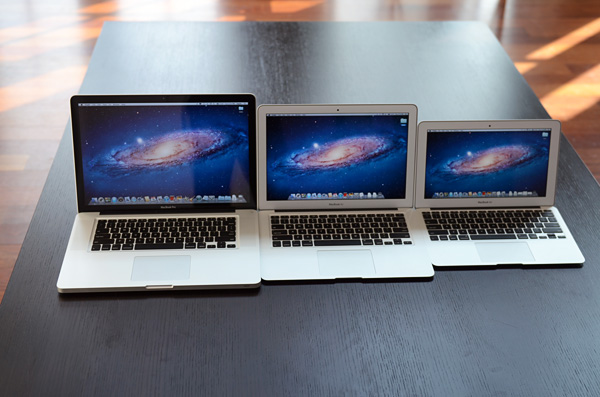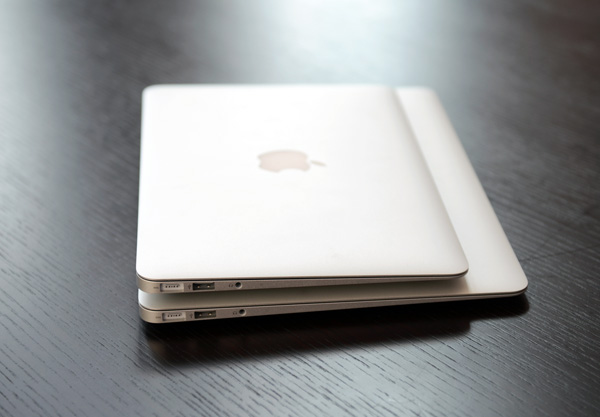The 2011 MacBook Air (11 & 13-inch): Thoroughly Reviewed
by Anand Lal Shimpi on July 28, 2011 3:25 AM EST- Posted in
- Apple
- Mac
- Intel
- Sandy Bridge
- MacBook Air
- Laptops
Final Words
Whereas last year's MacBook Air was a good machine for light work, the 2011 models are true replacements for mainstream portable Macs. There's still no dethroning the MacBook Pro (although the 13-inch model clearly needs a higher resolution display option), but for the rest of the world there are now some excellent ultra portable options that don't force you to really compromise on performance.
Both the 11 and 13-inch MacBook Air are fast enough to replace your 3 year old MacBook Pro and still deliver better performance. You can even move from a 2010 MacBook Pro to an upgraded MacBook Air and not notice any drop in performance. All of this is thanks to Intel's Sandy Bridge CPU.

From left to right: 15-inch MacBook Pro, 13-inch MacBook Air, 11-inch MacBook Air
It's the GPU performance that I'm less excited about. While last year's GeForce 320M isn't significantly faster than the HD 3000 in the new MacBook Air, it's still faster in our tests. There's not much Apple could've done about this. I don't believe a discrete GPU in an Air makes sense, but this should be a clear message to Intel. Sandy Bridge's GPU is the bare minimum, we need to really see a real ramp in performance from here on out. Ivy Bridge will give us a bit of that but not another doubling in GPU performance. Perhaps we'll see something significant from Haswell in 2013. For now, if you like gaming on the go you'll have to get a MacBook Pro.
When it comes to battery life the new MacBook Air doesn't break any records, but it doesn't disappoint either (at least under OS X). With the exception of the our light web browsing test, the new MacBook Air behaves pretty similarly to last year's model on battery power. The new 13 doesn't do anywhere near as well in mostly idle scenarios but under moderate to heavy load the new MBAs last at least as long as their predecessors.
The only move I would be careful about is a downgrade from a 13-inch 2011 MacBook Pro. The new 13-inch MBP is still considerably faster than the MacBook Air, while the more portable form factor is tempting you're better off waiting to see what Apple does with the next update to the MacBook Pro.
If you were a fan of the original MacBook Air, the 2011 models are just as significant of an introduction as the very first one in 2008. They may not look any different from the outside, but the new 11 and 13-inch MacBook Air are a significant step forward. These systems are no longer niche ultraportables, they've instead brought the ultraportable niche into the mainstream.
If you're stuck deciding between the two I think it breaks down like this. If you've got a beefy system at home and just need something portable for travel, the 11-inch Air is perfect. It's now fast enough to get real work done on the road and portable enough to feel like a tablet with an integrated keyboard. If you're replacing a primary notebook however, the 13 is the safer bet. It is sized like a normal notebook, you get longer battery life and a bigger screen to look at. If you're a fan of extremes, the 11 is for you. If you like balanced compromises, go with the 13.
What happens from here on out is what's really interesting. Intel has already committed to moving the TDP of its mainstream parts from 35W - 45W down to 10 - 20W. Since the Air is the new mainstream Mac notebook, Apple has already made that move. The performance in this 10 - 20W segment is going to get much better over the next two years, particularly once Haswell arrives.
The Thunderbolt Display is the first sign of what's to come. Moving IO controllers and expansion into the display, and potentially even moving discrete GPUs out of the notebook are all in store for us. Apple is really ahead of the curve here, but it's easy to imagine a future where laptops become a lot more like the new Air and shift to a couple high bandwidth ports instead of numerous lower bandwidth connections.
There's a lot to like with the new MacBook Airs; the last update was good, but performance was still often lacking. The MBA 11 in particular is now much more useful, and the 13 rightfully spells the end of the line for the old MacBook. While pricing is higher than typical 11" to 13" Windows laptops, you really can't find a competing Windows laptop with all the features the MBA offers without paying a similar price premium. You get a nice chassis with excellent build quality, decent displays that trump every budget laptop we've looked at, and reasonable battery life. If you like thin and light ultraportables, the MacBook Air continues to be one of the best options around.











103 Comments
View All Comments
name99 - Thursday, July 28, 2011 - link
"The WLAN solution in the Air is capable of up to two simultaneous spatial streams, topping out at 270Mbps.
In practice this results in peak performance over 802.11n at around 128.8Mbps.
"
This is a horribly misleading way of stating the issue. It implies that Apple or the chipset or something are somehow defective, in only delivering 50% of the available performance.
The ACTUAL problem is the 802.11 MAC & protocol, which wastes about 50% of the available bandwidth doing god knows what. The packets that go out, go out at of order 270Mbps, but 50% of the time packets are not going out.
This would be a good topic for a future AnandTech article --- just what the hell is the 802.11 MAC doing that wastes so much airtime?
A useful issue to discuss in the same article is the following:
I read once that there was an advanced option in the 802.11n MAC that reduced this wasted time to only (hah!) about 25%, but I have never seen details on this (and I have looked). Is it real? If it is real, does anyone support it?
ninjaquick - Thursday, July 28, 2011 - link
The relevance of SSDs is really only synthetics and low ram high cache situations. I do like seeing these get beat out squarely by an i3 in pretty much everything else in the win7 tests.bji - Friday, July 29, 2011 - link
How do you draw that conclusion about SSDs?KPOM - Friday, July 29, 2011 - link
They only get beaten out by the i3 in the 3D tests, which are driven by the GPU, so it's more fair to say that the HD 3000 gets beaten out by a discrete graphics adapter, which is no surprise. The Airs handily beat out the i3 in the CPU-intensive benchmarks.I've used an SSD since November 2008 and won't go back. I still need to use a HDD-equipped machine at the office, and I can't stand how long it takes to restart, shut down, or do anything disk intensive. The SSD made the Core 2 Duo-equipped MacBook Air tolerable in a world of i3s, i5s, and i7s. The Sandy Bridge-equipped MacBook Air with SSD makes it that much better.
Baron_Fel - Thursday, July 28, 2011 - link
When are you guys going to review the new Vaio Z? I want to know if that external GPU is worth anything.TwoStreetCats - Thursday, July 28, 2011 - link
I'm a very happy owner of the 2010 11" version and have to say that the form factor was the primary draw for me as I travel quite a bit. It fits quite nicely in the hydration pocket of my backpack and I hardly know that I have it with me.The only thing that is occasionally frustrating is the vertical resolution as the article mentions.
However, I use Mac Screen Rotate to rotate the screen and touchpad for portrait viewing when browsing or viewing pdf's and this problem is solved. If size and weight are serious factors for you, I highly recommend trying this out with the 11" before you decide that you need the 13".
www.macscreenrotate.com
bji - Friday, July 29, 2011 - link
If the TDP of the processor + graphics is 17W, why does the Macbook Air even need a fan?My Panasonic Y2, which I still use because I can't find a laptop I like better (just sold a Sager NP5160 that I only owned for 2 months because I couldn't stand the fan noise or the horrible keyboard), has a 22 W max TDP on just the Pentium M 1.4 Ghz processor. Probably the crummy Intel integrated graphics doesn't add more than a few watts but together they must be at least 25 W.
And yet, the Macbook Air, with a 17 W processor + graphics combined, has a fan. There is plenty of aluminum in the body of the Macbook Air to act as a heatsink, why does Apple even need to put a fan in there? If the Y2 can go fanless, surely the Air can.
bji - Friday, July 29, 2011 - link
OK, turns out the Pentium M in my Panasonic Y2 is the 10 watt Pentium M 738, not the 22 watt Banias Pentium M.The Intel 855 GME chipset is listed at 3.2 W.
Is it really the case that 10 W can be fanless but 17 W cannot?
tipoo - Friday, July 29, 2011 - link
Might be possible in 17w, but it already gets pretty hot WITH a fan.hellknight - Friday, July 29, 2011 - link
I couldn't believe that Intel included AES instruction set in such low voltage chips. Even the base model has those.. This is something very great.. It would be great for all Truecrypt users..